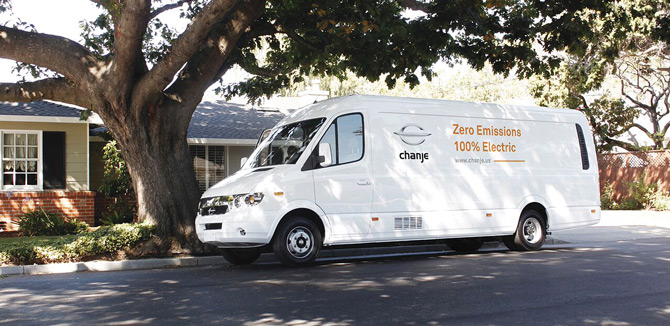Electric-vehicle maker Chanje recently announced the delivery of its first order to Ryder System Inc., one of the largest medium-duty truck fleet management companies in the country.
Playa Vista-based Chanje, whose name is pronounced “change,” delivered 125 of its electric vehicles set to be in use by Ryder at the end of the year, the car maker said. Miami-based Ryder also is the exclusive distribution and service provider for Chanje’s medium-duty EV fleet.
“There is a pent-up customer demand for commercial electric vehicles which makes today’s delivery of Chanje electric trucks to Ryder a significant milestone,” Bryan Hansel, chief executive of Chanje, said in a statement.
Chanje’s product, a zero-emission all-electric delivery truck, is designed to haul up to 6,000 pounds of goods with a 100-mile range and is meant to compete against similar short-haul commercial vehicles on the “last mile,” or the last leg of product movement. That’s often a relatively short hop from a distribution or processing center en route to the final destination, such as a customer’s home.
The company is backed by Hong Kong-based FDG Electric Vehicles, which makes battery packs and electric vehicles in Hangzhou, China. FDG, Chanje and other partners have invested nearly $1 billion combined into developing the product, Hansel said in August.
FDG has the rights to sell the trucks in China, while Chanje has U.S. distribution. The price tag hasn’t yet been revealed.
“The company hasn’t announced the price yet, but we can say that the total cost of ownership of a Chanje vehicle will be comparable to an equivalent diesel truck when you consider the fuel and maintenance savings of an electric vehicle,” Chanje spokeswoman Stacy Morris said.
A similar non-electric vehicle, Ford Motor Co.’s transit cargo van, is priced at about $32,000.
Chanje’s management team includes executives with experience at companies including Tesla Inc., Volkswagen and Ford Motor Co. as well as the Los Angeles Cleantech Incubator.
Lime Time
A new bike ridesharing service launched in Los Angeles on Nov. 6 in all its bright lime glory.
LimeBike, a San Mateo-based provider of dockless bike-sharing is providing yet another option for Angelenos to get around from one point to another.
“Today’s launch marks the first dockless bikeshare to come to L.A., which is exciting because together, we can change the future of transportation, communities, and cities to make them the best they can be,” Toby Sun, chief executive, said in a statement.
Other local cities and agencies have created bike-sharing programs with some of LimeBike’s competitors.
Santa Monica-based Cyclehop has helped Long Beach, Santa Monica, Beverly Hills and West Hollywood all establish bicycle-sharing programs. Metro partnered with Philadelphia-based Bicycle Transit Systems to create Metro Bike Share.
LimeBike said the difference between it and other bike-sharing services is that it doesn’t have designated places to return bikes, what the company describes as a “dockless” system.
“This allows people to go wherever they want and not have to worry about returning bikes to a certain location,” LimeBike spokeswoman Mary Caroline Pruitt said.
The company will begin offering 250 bikes in City Council District 15, which includes the neighborhoods of San Pedro, Wilmington, Vinegar Hill, Harbor City and Harbor Gateway, among others.
“We’re excited to be the first district in Los Angeles to bring this revolutionary dockless cycling technology to our citizens,” Councilman Joe Buscaino of District 15 said in a statement.
The company isn’t concerned about theft since the bikes are equipped with an anti-theft lock and an alarm system that goes off when the bikes are moved without being unlocked first via its app, Pruitt said.
The app is available for download on iOS and Android smartphones. The bikes are GPS and 3G-enabled and can be found via the app.
Rides cost $1, or 50 cents for students,
for 30 minutes. When the ride is finished, riders lock the bike’s back wheel and park between the sidewalk and the street curb or
at a bike rack.
Port Drone Permits
The Port of Long Beach now requires drone operators to obtain a permit before taking off or landing in the Harbor District.
Anyone operating a drone must show proof of insurance, provide registration information and takeoff and landing plans and obtain permission from occupants of any port facilities to be overflown, port officials said.
The permitting process was developed with Federal Aviation Administration guidelines in mind by port security, risk management and commercial operations staff and the Long Beach City Attorney’s Office, port Executive Director Mario Cordero said in a statement.
“The approved rules, with requirements for insurance and notifications, should enhance our ability to maintain a safe environment for cargo operations in the Port,” he said.
The cost for the permit is $100 and those interested should apply a few weeks before flying as the process can take up to 10 days, ports spokesman Lee Peterson said.
For more information, visit www.polb.com/drones.
The neighboring Port of Los Angeles has no requirements on drone permits as of yet.
Staff reporter Shwanika Narayan can be reached at [email protected] or 323-556-8351.

